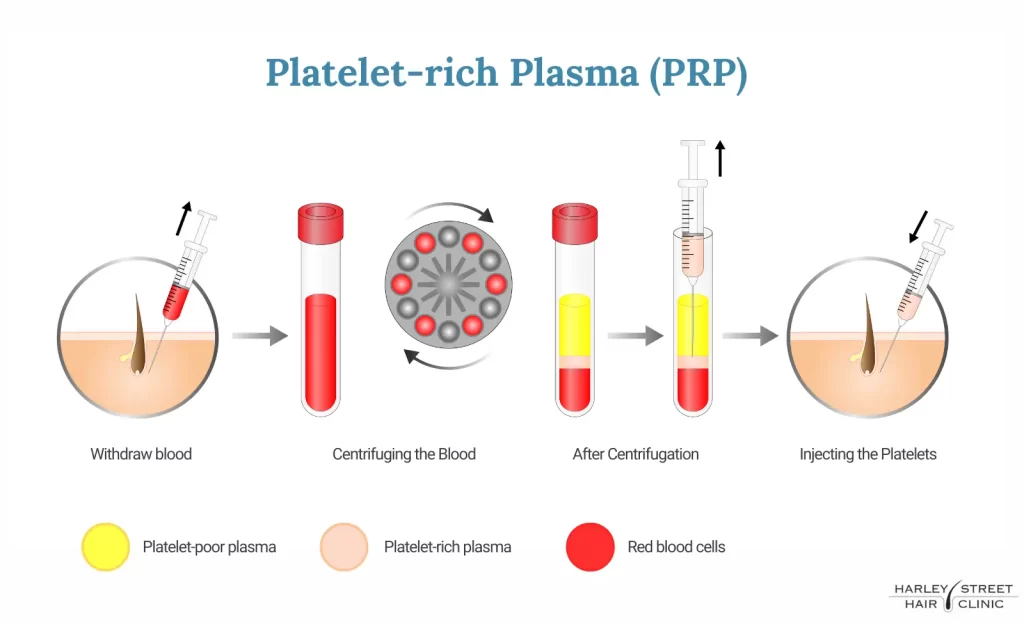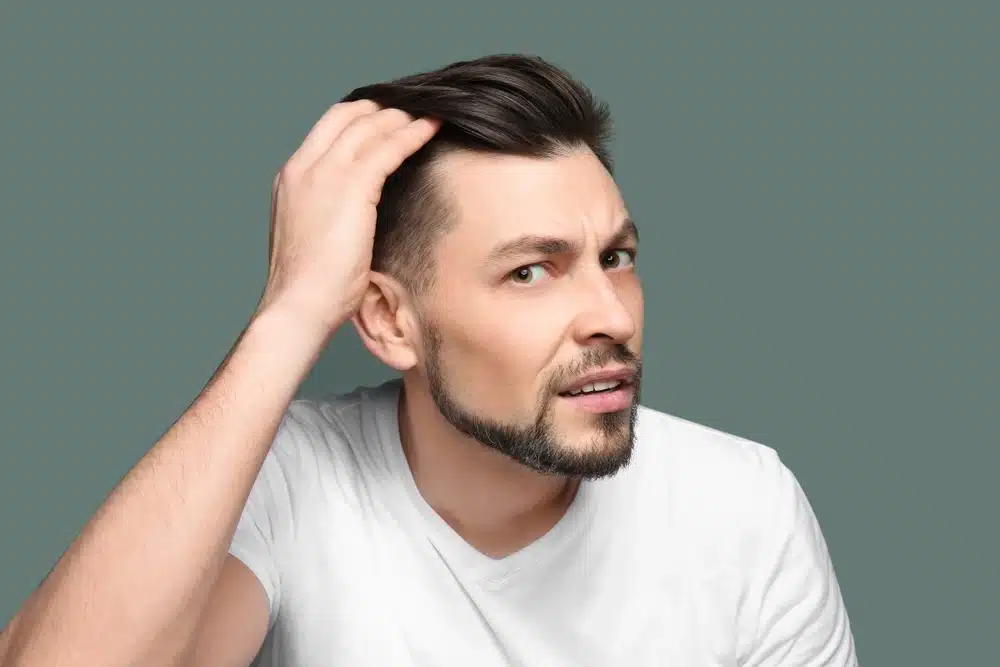If you are on a mission to improve your hair health or regrow your hair altogether, you have likely stumbled across various beneficial alopecia-fighting treatments, including PRP. PRP is a particularly exciting treatment, as it uses your blood for healing purposes. Plus, there is a lot of scientific evidence proving just how effective it is at stimulating hair growth. Learn all about this hair loss treatment right here!
What is PRP?
PRP stands for platelet-rich plasma and is a hair regrowth process that involves drawing a patient’s blood, processing the blood in a centrifuge machine, and then using the plasma in scalp injections. The process in the centrifuge machine is important, as it’s during this point when the red and white blood cells become separated from the blood platelets and plasma, the latter parts being what’s needed in PRP treatments.
PRP hair treatments work thanks to the platelet’s growth factors, which stimulates hair growth. It takes around six months for the effects of PRP injections to work, at which point most people will experience thicker hair, improved hair density, and new growth.
The 10 Benefits of PRP Hair Treatment
Are you on the fence about getting PRP treatments for hair regrowth? These benefits may sway you.
- No Scars
Many hair restoration treatment plans involve processes that leave scarring on the scalp. That’s not the case with a PRP hair treatment – the process is simple and involves only needles, meaning your scalp won’t have any leftover scarring once those initial minor wounds have healed.
- It’s Effective
Even without any scarring, the treatment wouldn’t be worth it if it wasn’t effective. The good news is that the science backs it up! Several studies have been performed looking into the effectiveness of PRP treatments on hair regrowth, many of which have been positive. One 2022 review [1] looked at four studies that involved 177 patients, with the results showing a significant increase in hair density after the PRP injections.
- It’s Minimally Invasive
PRP hair treatments are not as invasive as some other treatments, such as surgery. The process is pretty simple, involving blood drawing and then the injections that go directly into the scalp. In fact, there isn’t even a need for local anaesthesia during any part of PRP treatments.
- It Promoted Cell Growth
One of the ways PRP treatments work is by regenerating damaged tissues. It can then help the hair follicles stimulate hair growth – on top of that, the treatment also boosts things like elastin and collagen.
- It Helps Different Types of Hair Loss
While PRP treatments are often offered to people with androgenetic alopecia (male and female pattern baldness), they can help various types of hair loss. For example, people who have suffered from telogen effluvium during postpartum have greatly benefited from PRP.
- There Aren’t Many Side Effects
You won’t have to worry yourself with scary side effects. While there are some potential side effects, common ones being soreness and itching after the procedure, most aren’t too serious and will go away with time. Some more severe side effects include injury to the blood vessels or nerves, but these are extremely uncommon and can be treated by your doctor.
- A Personalized Treatment
One of the best things about PRP hair treatments is that the medicine comes from your own body! Not only does this make it completely natural with no chance of the medicine getting rejected, but it also means the treatment can be customized to suit your needs – no matter what’s causing your hair loss, PRP can help.
- The Results Look Natural
Most people looking into hair restoration options prefer to avoid treatments that leave them looking like their hairline isn’t natural. PRP injections are a good option, as the results look like normal hair regrowth. No one would even be able to tell you had a procedure.
- It Won’t Cause Allergies
The blood draw is taken straight from the patient, and the platelets are injected back into them. As a result, there is no chance of allergies, as the treatment comes from your own body.
- PRP Can Treat Other Conditions
While PRP works wonderfully for hair growth, that doesn’t mean that’s all it can treat! PRP has been effective at treating a range of other problems, including sports conditions [2] like neck and back pain, tennis elbow, cartilage injuries, and tendon injuries. It’s a very versatile treatment!
What About Downsides?
While there are many benefits to getting a PRP treatment for hair loss, it’s worth looking at the potential downsides, too, especially if you’re considering which hair restoration treatment to opt for. First, there’s the cost – PRP injections aren’t exactly cheap, so you’ll need to weigh up whether the treatment is worth it for your case.
Another minor downside some patients may be put off by is the fact it takes several sessions to work. Then, following those sessions, you’ll need to wait around six months (or even nine) for results to show through. While this is normal due to the typical rate of hair growth, it does mean patience is necessary. It also means you’ll have to wait sometime before seeing whether the treatment has or hasn’t been effective, which can be frustrating!
Should You Get PRP?
Even with these slight downsides, PRP is still a highly effective treatment that’s more than worth it for many patients. There are a few things to consider, including:
Cost: Most PRP injection treatments will cost upwards of £1,000, with many full treatments going into five figures. Naturally, this is something to think about before deciding on the treatment.
Risks: While there are a few risks, it wouldn’t be wise to go into a treatment like this without looking into them. You can speak about potential side effects with your dermatologist.
Your Type of Hair Loss: Some types of hair loss won’t be as treatable with PRP as others. For example, severe cases of alopecia areata may not respond as well to the treatment as someone with androgenetic alopecia.
Ultimately, it’s up to you – speak with a doctor to determine whether PRP injections are a good path for restoring your hair loss.
What to Expect from PRP Treatment: 5 Steps
Have you decided to get PRP treatments? If so, here’s what to expect:
Step One: Initial Consultation
Before anything can begin, you’ll go through an initial consultation. At this stage, your doctor will ask you the necessary questions and perform some physical examinations to determine whether you are a good candidate for the treatment, and if so, they’ll be able to devise an appropriate treatment plan for you.
Step Two: Blood Draw
The first step of the treatment involves a blood draw, which is taken from you – the patient. This should be painless and quick.
Step Three: Centrifuging the Blood
Next, the blood goes into a centrifuge, which separates the white blood cells, red blood cells, and platelets. The platelets then get used in the next step.
Step Four: Injecting the Platelets
The platelets then get injected directly into the scalp; it’s a minimally invasive process that shouldn’t be painful.
Step Five: Aftercare
Following the procedure, your doctor will provide aftercare. This will usually involve follow-up appointments to see how your scalp heals from the injections. You’ll also be given specific instructions – for example, your doctor may tell you not to take anti-inflammatory medications after the treatment. At this stage, you can monitor your hair growth over the following weeks and months to see how effective the treatment is. A hair track app works well for this.
Other Solutions for Hair Loss
Is PRP not for you? Perhaps your doctor decided you are not a good candidate, or maybe you have tried PRP before, and it wasn’t as effective for you as you’d hoped. In this case, there are other hair restoration options you could try:
Hair Loss Medications
There are several hair loss medications available that are effective at treating androgenetic alopecia. Minoxidil is useful for both male and female pattern hair loss, and you can get it over the counter. Finasteride and Dutasteride are both treatments specifically for male pattern baldness but have proven highly effective for many patients.
Hair Transplants
A hair transplant is a minimally invasive type of surgery that involves grafting hair follicles and transplanting them to the problem area of the scalp. This procedure produces excellent results – even patients with severe androgenetic alopecia are able to regrow hair with this method. While it’s a little more invasive than PRP injections, it’s not by much, especially if you choose a FUE hair transplant, which grafts only single hair follicles at a time.
PRP Treatment for Hair Restoration: Final Thoughts
Overall, PRP treatments are highly effective hair restoration options that involve drawing your blood and then using the growth factors of your platelets to stimulate hair growth on the scalp. Already, many people have benefited from this treatment, and you could be next.
Are you interested in learning more about hair restoration options? Perhaps you are looking into FUE hair transplants. In that case, get in touch to speak to an expert or check out our patients gallery to see the results we can offer.
Sources:
- https://www.ncbi.nlm.nih.gov/pmc/articles/PMC8922312/
- https://www.yalemedicine.org/conditions/platelet-rich-plasma-injections




